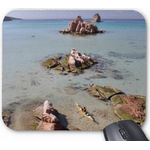On this stage we start a tour through the Bolivian pampas of the Amazon basin. The dirt road from Trinidad to San Borja is absolutely flat, which means a radical change in our trip. On both sides of the road, an endless savannah stretches, dotted with forest islands and lagoons teaming with life: alligators, aquatic birds and fish waiting for the first rains to escape from the small pools that makes them so vulnerable now. We start the ride sweating under a scorching sun, which is another significant change over the past 7 months. But the cold keeps following us and even at latitude 15 and only 450 feet above sea level, we are cold for a couple of nights. The Surazo, as it's commonly known here, is a phenomenon that brings clouds and cold winds from the South and lowers the temperature about 35 degrees. While the surazo lasts, wildlife hides in the bushes, drastically reducing its activity. When it goes away, temperatures climb above 90F. Alligators lie in the sun again and the songs of birds and the screams of parrots and macaws can be heard all over again.
Stage index:
August 17, 2011: From Trinidad to a Estancia
August 18, 2011: From a Estancia to San Ignacio de Moxos
August 19, 2011: From San Ignacio to Estancia Chevejecure
August 20, 2011: From the Estancia Chevejecure to the Beni Biosphere Reserve Station
August 21, 2011: From the Beni Biosphere Reserve Station to San Borja
August 22 to 25, 2011: Beni Biosphere Reserve
Profile for the entire stage:

August 17, 2011: From Trinidad to a Estancia
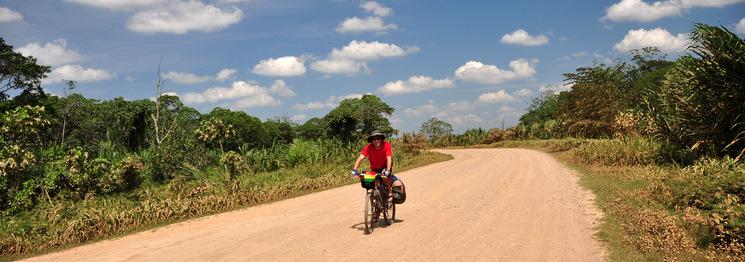
Once we leave Trinidad, as soon as the buildings disappear, we realize that the terrain is totally flat as far as the eye can see. After the mountainous places we've been riding during the last months, this one seems like a dream. The highest climbs we have to overcome are the bridges over a canal or a river. We probably have to go up a full 6 feet of altitude :)
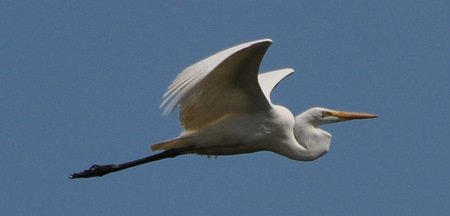 A few miles from Trinidad, we start seeing all kinds of birds, particularly waterfowl such as herons and moorhens. On both sides of the paved road there are many small lakes, most of them partially covered by aquatic plants. The road is paved till the crossing by ferry of the Mamore river, one of the largest in the area. From there, it´s unpaved and not in very good condition. We feel that we should ride faster. Ideally, we wanted to cover the 58 miles to San Ignacio, but it’s not going to happen. Perhaps the heat is the factor that is consuming our energy. Between that and a mild headwind, we move slower than expected. The wind is annoying because it slows us down, but when it stops blowing we want it to start again to relieve the heat.
A few miles from Trinidad, we start seeing all kinds of birds, particularly waterfowl such as herons and moorhens. On both sides of the paved road there are many small lakes, most of them partially covered by aquatic plants. The road is paved till the crossing by ferry of the Mamore river, one of the largest in the area. From there, it´s unpaved and not in very good condition. We feel that we should ride faster. Ideally, we wanted to cover the 58 miles to San Ignacio, but it’s not going to happen. Perhaps the heat is the factor that is consuming our energy. Between that and a mild headwind, we move slower than expected. The wind is annoying because it slows us down, but when it stops blowing we want it to start again to relieve the heat.
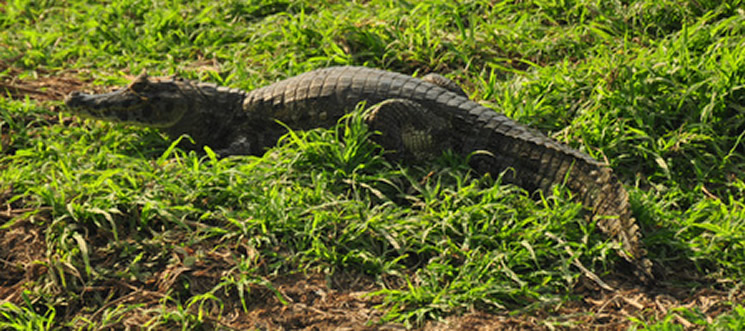 After a few miles from the Mamore River is when we really realize we are in the jungle. In most of this area, the forest has been destroyed for cattle grazing. However, the fauna, especially birds, is everywhere. In the lagoons there is always something else besides the omnipresent herons and moorhens. We see cormorants, a kingfisher, jaribus, gray herons, a roseate spoonbill and others we don’t know the name. In areas where trees are still standing, we hear all kinds of bird calls. The green parrots that we have been seeing for weeks are even more common here. In addition, there is a whole new variety of birds darting from one side of the road to the other. We also see 3 or 4 species of raptors, including our friends the caracaras we have been seeing from Tierra del Fuego. As for land animals, at first we only see ran over snakes. The sighting that certainly convinces us that we are in the jungle is the first black caiman. There it is lying in the sun, about 15 feet from the road. This one is about 6 feet, but they can reach up to 18. In the same area we see the other species of caimans inhabiting the savanna. These are called “lizards” here. These are much smaller and more elusive. When the sun begins to fall, the activity clearly increases. In the shadows of the bushes we scare away 3 capybaras, the largest tailless rodent, They run back to the forest terrified making a noise in between a neigh and a spit.
After a few miles from the Mamore River is when we really realize we are in the jungle. In most of this area, the forest has been destroyed for cattle grazing. However, the fauna, especially birds, is everywhere. In the lagoons there is always something else besides the omnipresent herons and moorhens. We see cormorants, a kingfisher, jaribus, gray herons, a roseate spoonbill and others we don’t know the name. In areas where trees are still standing, we hear all kinds of bird calls. The green parrots that we have been seeing for weeks are even more common here. In addition, there is a whole new variety of birds darting from one side of the road to the other. We also see 3 or 4 species of raptors, including our friends the caracaras we have been seeing from Tierra del Fuego. As for land animals, at first we only see ran over snakes. The sighting that certainly convinces us that we are in the jungle is the first black caiman. There it is lying in the sun, about 15 feet from the road. This one is about 6 feet, but they can reach up to 18. In the same area we see the other species of caimans inhabiting the savanna. These are called “lizards” here. These are much smaller and more elusive. When the sun begins to fall, the activity clearly increases. In the shadows of the bushes we scare away 3 capybaras, the largest tailless rodent, They run back to the forest terrified making a noise in between a neigh and a spit.
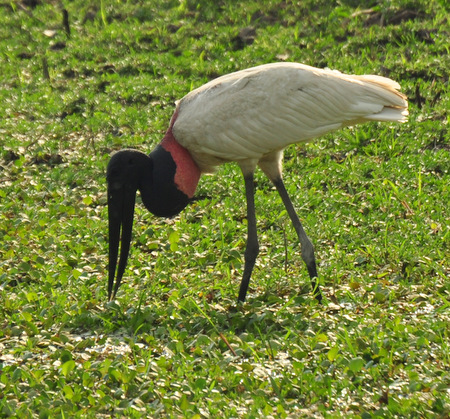 After seeing the alligators and so many crushed snakes we don’t feel like camping in the open, so we enter the grounds of an estancia and ask for permission to camp. Before having to ask for a space in the house, the woman offers it to us. While chatting, she invites us to a toronja refreshment we cannot refuse. It's a mixture of toronja juice, water (of unknown origin) and sugar. We can even have a shower using a bucket and a bowl, which is great to clean off the layer of sweat, sun screen and dust over our skin, especially on the legs. It was a great idea buying flip-flops in Trinidad. For this area they work well enough with the toe clips and keep our feet cool.
After seeing the alligators and so many crushed snakes we don’t feel like camping in the open, so we enter the grounds of an estancia and ask for permission to camp. Before having to ask for a space in the house, the woman offers it to us. While chatting, she invites us to a toronja refreshment we cannot refuse. It's a mixture of toronja juice, water (of unknown origin) and sugar. We can even have a shower using a bucket and a bowl, which is great to clean off the layer of sweat, sun screen and dust over our skin, especially on the legs. It was a great idea buying flip-flops in Trinidad. For this area they work well enough with the toe clips and keep our feet cool.
Reina, the lady of the house, offers us fish and rice for dinner, thanks to his 6 year old son catch. Six years! And I've only able to catch 2 trouts in 7 months... When I was 6 years old, I didn’t know what a fishing rod was. Despite the shower and the fact that the sun set a while ago, the heat remains strong when we go to bed. Last time we used the sleeping bags, those were the winter one. We are now carrying the summer ones, but we only use them to avoid direct contact with the nylon mattresses.
Go to top
August 18, 2011: From a Estancia to San Ignacio de Moxos
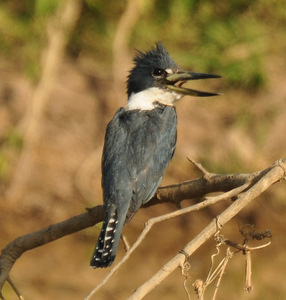 After yesterday‘s heat today we leave very early to take advantage of the cool morning and before 8 AM we're on the road. The other reason to get up early is to be out during the busiest hours for the animals. After 9:30, the activity of birds is greatly reduced, but before then, we see a lot of them. Besides the species we saw yesterday, today we see another raptor species and several birds with colorful plumage, one with a red head and another with yellow spots on the base of the tail and belly.
After yesterday‘s heat today we leave very early to take advantage of the cool morning and before 8 AM we're on the road. The other reason to get up early is to be out during the busiest hours for the animals. After 9:30, the activity of birds is greatly reduced, but before then, we see a lot of them. Besides the species we saw yesterday, today we see another raptor species and several birds with colorful plumage, one with a red head and another with yellow spots on the base of the tail and belly.
When animal activity goes down, the road becomes duller and the stones are more noticeable. A few miles before San Ignacio we pass the "marchers". This is a group of Indians who have organized a march in protest against the route of a road from La Paz to San Ignacio that crosses the National Park where they live. Right now they are heading for San Ignacio, but if the government doesn’t listen to their requests, they’ll continue marching till La Paz. This morning we stopped for breakfast at Fatima. That's where they spent the night and, according to the owner of the kiosk where we buy some cookies, the marchers drunk lots of alcohol before resuming the march at 3 AM. It is understandable that they walk at night, but one of these days they are going to take the wrong direction...
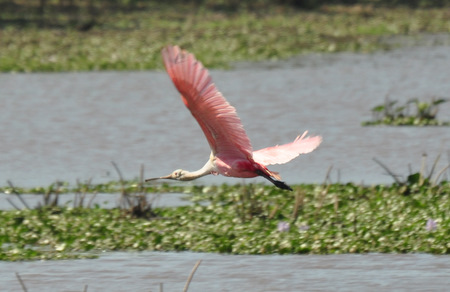 When we arrive at noon to San Ignacio we're exhausted. It has been only 30 mi and a total of 20 feet of elevation. Yes, 20 feet accumulated. It’s clear that our expectations of increasing the average miles per day are wrong. The heat is almost unbearable and, despite the sunscreen, we have a couple of small sunburns. The hotels in town are reserved almost entirely for the marchers, but we can still find something. We take shelter from the sun and heat in the room with the fan at full speed for a couple of hours.
When we arrive at noon to San Ignacio we're exhausted. It has been only 30 mi and a total of 20 feet of elevation. Yes, 20 feet accumulated. It’s clear that our expectations of increasing the average miles per day are wrong. The heat is almost unbearable and, despite the sunscreen, we have a couple of small sunburns. The hotels in town are reserved almost entirely for the marchers, but we can still find something. We take shelter from the sun and heat in the room with the fan at full speed for a couple of hours.
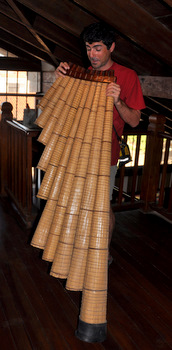 In the afternoon we visit the museum. There they keep 7000 scores of indigenous baroque music, heritage of the ones the Jesuits brought from Europe along with the violins. The style has been evolving and mixing with local instruments like the bassoon. It consists of several conical tubes of different sizes joined together linearly to be played like a harmonica. The guided tour also includes the church of San Ignacio de Loyola (which, by the way, is also the official name of the village) and its sacristy where the statues used in the Holy Week processions are displayed. In addition, there are 3 rooms with religious objects made of silver, masks, musical instruments and a model of the original village.
In the afternoon we visit the museum. There they keep 7000 scores of indigenous baroque music, heritage of the ones the Jesuits brought from Europe along with the violins. The style has been evolving and mixing with local instruments like the bassoon. It consists of several conical tubes of different sizes joined together linearly to be played like a harmonica. The guided tour also includes the church of San Ignacio de Loyola (which, by the way, is also the official name of the village) and its sacristy where the statues used in the Holy Week processions are displayed. In addition, there are 3 rooms with religious objects made of silver, masks, musical instruments and a model of the original village.
In the evening we repair the punctured tube and the pore in one of the sleeping mats. When the heat begins to subside, we go shopping. Yesterday, while fixing one of the 3 flats, a tube valve broke (the second in the last weeks). Now we only have one spare and we are moving away from civilization gradually. But the only tubes we can find here have a valve too thick for our rims. We’ll see if we can find a more suitable one in San Borja.
Go to top
August 19, 2011: From San Ignacio to Estancia Chevejecure
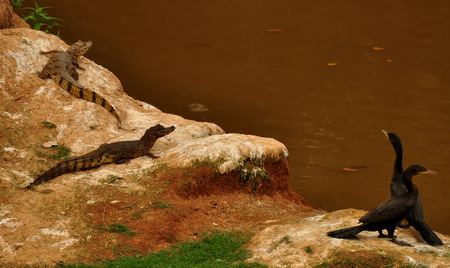 Today we wanted to leave early as yesterday but when we put on the sunscreen we realize that we don’t have enough to get to San Borja. We look for some in all the pharmacies and stores but we can’t find any. Finally we buy a half empty tube from the owner of the hotel where we spent the night. And this is not the only delay for the day. A few miles from the village we find the road blocked by a couple of trucks and a group of citizens of San Ignacio. These are against the marchers. We try to convince them to let us pass. "Here nobody goes ahead, no matter how much you pay". After a few minutes, one of the guys next to the barrier suggests us to move on. We start to push the bikes on the side of the barrier and since no one says anything we keep on going. We go behind a truck to avoid drawing any attention and start pedaling at a good pace until we are far enough.
Today we wanted to leave early as yesterday but when we put on the sunscreen we realize that we don’t have enough to get to San Borja. We look for some in all the pharmacies and stores but we can’t find any. Finally we buy a half empty tube from the owner of the hotel where we spent the night. And this is not the only delay for the day. A few miles from the village we find the road blocked by a couple of trucks and a group of citizens of San Ignacio. These are against the marchers. We try to convince them to let us pass. "Here nobody goes ahead, no matter how much you pay". After a few minutes, one of the guys next to the barrier suggests us to move on. We start to push the bikes on the side of the barrier and since no one says anything we keep on going. We go behind a truck to avoid drawing any attention and start pedaling at a good pace until we are far enough.
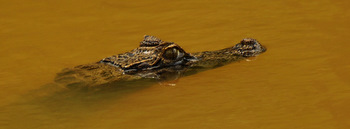 Passing through the community of Puerto Borja, we stop to buy water and have lunch. As we gobbled up the crackers with tuna, the young girls from the store come to chat with us and they give us 2 toronjas. These are similar to grapefruit, but they taste like sweet oranges, although they have a little bit of the bitterness of grapefruit. They are huge and have lots of juice.
Passing through the community of Puerto Borja, we stop to buy water and have lunch. As we gobbled up the crackers with tuna, the young girls from the store come to chat with us and they give us 2 toronjas. These are similar to grapefruit, but they taste like sweet oranges, although they have a little bit of the bitterness of grapefruit. They are huge and have lots of juice.
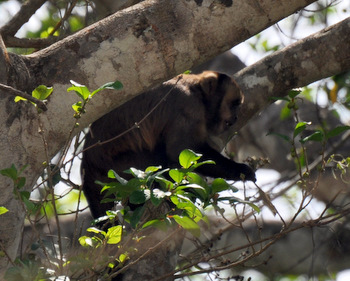 The road is similar to yesterday’s, although the terrain has improved somewhat. The heat is just as strong. In the morning news, they forecast Southerly winds for this afternoon. That usually means falling temperatures. Sometimes the drop is considerable and the effect is known as surazo. Let's hope so. As for wildlife, we keep seeing all kinds of birds, with some new ones and some alligators. However, the highlight of the day is the spotting of a pair of monkeys in an area with abundant trees. When we stop next to them, they gradually move into the deep forest, jumping from branch to branch.
The road is similar to yesterday’s, although the terrain has improved somewhat. The heat is just as strong. In the morning news, they forecast Southerly winds for this afternoon. That usually means falling temperatures. Sometimes the drop is considerable and the effect is known as surazo. Let's hope so. As for wildlife, we keep seeing all kinds of birds, with some new ones and some alligators. However, the highlight of the day is the spotting of a pair of monkeys in an area with abundant trees. When we stop next to them, they gradually move into the deep forest, jumping from branch to branch.
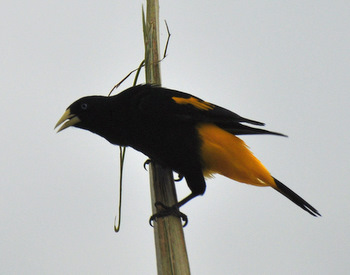 In the afternoon we pass by the estancia Chevejecure and ask for permission to camp on their property. One of the palms there is home for a flock of weaver birds. From the palm leaves, several pouch-like nests hang made of woven straw and twigs. To clean off all the dust in our body, we take water from the lagoon next to the house and wash the best we can. While there is light we take some time to lube the chains, but when it gets dark, the mosquitoes are everywhere and we get into the tent. Outside, the wind died out long ago and although we have only the screen door closed, the heat inside the tent is suffocating. We use our dishes as fans to cool off, but when we stop we start sweating again. We lie over the silk sleeping bags and try to sleep while we are still dripping. Luckily, we fall asleep soon. Before dawn, we wake up cold, but the sleeping bags are warm enough for tonight.
In the afternoon we pass by the estancia Chevejecure and ask for permission to camp on their property. One of the palms there is home for a flock of weaver birds. From the palm leaves, several pouch-like nests hang made of woven straw and twigs. To clean off all the dust in our body, we take water from the lagoon next to the house and wash the best we can. While there is light we take some time to lube the chains, but when it gets dark, the mosquitoes are everywhere and we get into the tent. Outside, the wind died out long ago and although we have only the screen door closed, the heat inside the tent is suffocating. We use our dishes as fans to cool off, but when we stop we start sweating again. We lie over the silk sleeping bags and try to sleep while we are still dripping. Luckily, we fall asleep soon. Before dawn, we wake up cold, but the sleeping bags are warm enough for tonight.
Go to top
August 20, 2011: From the Estancia Chevejecure to the Beni Biosphere Reserve Station
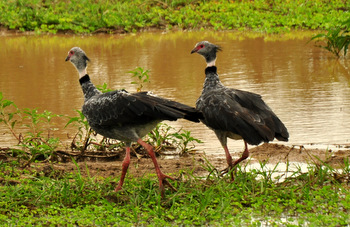 The sky is completely overcast and outside of the tent is cold. It seems that the surazo has arrived. Being cold is our fate, even in the jungle. We start pedaling with 2 shirts, one with long sleeves.
The sky is completely overcast and outside of the tent is cold. It seems that the surazo has arrived. Being cold is our fate, even in the jungle. We start pedaling with 2 shirts, one with long sleeves.
In this area one of the macaw species is especially abundant. Although the gray day makes it difficult to identify them, we think it's green, blue and red. A couple of times we see an animal the size of a cat, but with a furry tail crossing the road, but too far away to identify it.
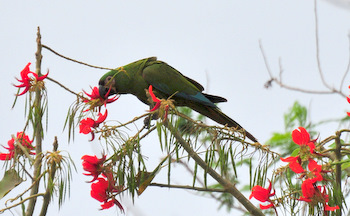 During the day it rains a few times but we shelter under a tree for a few minutes until it stops. After lunch the rain becomes more constant, although still weak. Within a few miles we pass the Beni Biosphere Reserve station. We want to visit the reserve, but we were told over the phone they are not receiving visitors. We can still visit it, but we have to organize it in San Borja, where the main office is. Anyway, we want to chat with the rangers to see what options we have. We go in, but nobody is there. Actually, the site seems abandoned, but supposedly there should be two rangers. It’s still raining, and although it is only 1:30 PM, we decide to stay here for the night. Anyway, today we wouldn’t be able to ride the 32 mi left until San Borja. On the other hand, it’s not fun to pedal in the rain.
During the day it rains a few times but we shelter under a tree for a few minutes until it stops. After lunch the rain becomes more constant, although still weak. Within a few miles we pass the Beni Biosphere Reserve station. We want to visit the reserve, but we were told over the phone they are not receiving visitors. We can still visit it, but we have to organize it in San Borja, where the main office is. Anyway, we want to chat with the rangers to see what options we have. We go in, but nobody is there. Actually, the site seems abandoned, but supposedly there should be two rangers. It’s still raining, and although it is only 1:30 PM, we decide to stay here for the night. Anyway, today we wouldn’t be able to ride the 32 mi left until San Borja. On the other hand, it’s not fun to pedal in the rain.
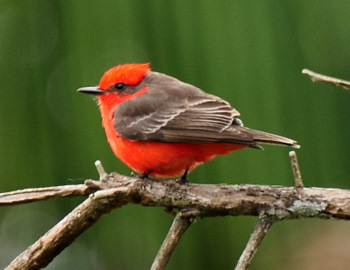 Most of the station buildings are partially in ruins. Most of the roofs made of palm leaves have collapsed but we camp under a solid ceiling of a standing porch. Among the houses there is a great variety of trees of considerable size. The ground is full of fruits: grapefruit, coconuts, dates, tangerines, jackfruit... Colorful little birds scoot between trees. High on a tree, a few yards from the offices, lives a community of macaws. When the sun is setting, a chorus of bird calls starts but the screams of the macaws stand out. It sounds like a yelling war between macaw gangs. You can’t get bored while walking through the trees of the station, especially for the variety and number of birds. When it gets dark we see a jochi, similar to a capybara but rather smaller. At night, we wake up due to a noise that looks like an animal scratching through the logs. With the headlight we find the perpetrator, a mammal similar to a weasel.
Most of the station buildings are partially in ruins. Most of the roofs made of palm leaves have collapsed but we camp under a solid ceiling of a standing porch. Among the houses there is a great variety of trees of considerable size. The ground is full of fruits: grapefruit, coconuts, dates, tangerines, jackfruit... Colorful little birds scoot between trees. High on a tree, a few yards from the offices, lives a community of macaws. When the sun is setting, a chorus of bird calls starts but the screams of the macaws stand out. It sounds like a yelling war between macaw gangs. You can’t get bored while walking through the trees of the station, especially for the variety and number of birds. When it gets dark we see a jochi, similar to a capybara but rather smaller. At night, we wake up due to a noise that looks like an animal scratching through the logs. With the headlight we find the perpetrator, a mammal similar to a weasel.
Go to top
August 21, 2011: From the Beni Biosphere Reserve Station to San Borja
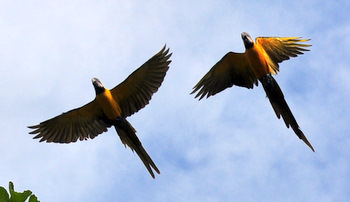 Today there are no roosters in miles, but the macaws are equally or even more effective in waking us up. The screaming on the trees and palm trees around us is amazing. When we go out of the tent we see 2 flocks around 20 or 25 individuals each. The other birds make their calls shyly. Before we start riding, we approach the tiny lagoon of the station. Here we see more herons, a flock of huge ducks and a pair of southern screamers.
Today there are no roosters in miles, but the macaws are equally or even more effective in waking us up. The screaming on the trees and palm trees around us is amazing. When we go out of the tent we see 2 flocks around 20 or 25 individuals each. The other birds make their calls shyly. Before we start riding, we approach the tiny lagoon of the station. Here we see more herons, a flock of huge ducks and a pair of southern screamers.
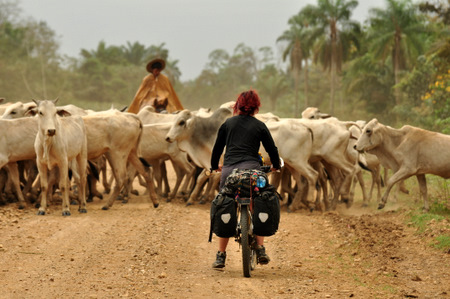 During the bike ride there are no big excitements. The day is gray like yesterday and, wearing long sleeves, the temperature is pleasant to ride. In fact, last night, the silk sleeping bags were not enough and we had to sleep with pants and long sleeves. As we approach San Borja, wildlife is less abundant and it’s replaced by livestock and pets. Tomorrow we will go to the park main office to see if we can arrange a tour inside the reserve.
During the bike ride there are no big excitements. The day is gray like yesterday and, wearing long sleeves, the temperature is pleasant to ride. In fact, last night, the silk sleeping bags were not enough and we had to sleep with pants and long sleeves. As we approach San Borja, wildlife is less abundant and it’s replaced by livestock and pets. Tomorrow we will go to the park main office to see if we can arrange a tour inside the reserve.
Go to top
From August 22 to 25, 2011: Beni Biosphere Reserve
 At the reserve offices in San Borja we organize our visit with Pedro and Johnny, the rangers of the station. We spend the rest of day wandering around, when the heat allows, watching a cockfight, where only men are present and taking it easy.
At the reserve offices in San Borja we organize our visit with Pedro and Johnny, the rangers of the station. We spend the rest of day wandering around, when the heat allows, watching a cockfight, where only men are present and taking it easy.
The next day we meet with the rangers at the station, where we slept 3 nights ago. Pedro and Johnny arrive on one motorcycle accompanied by Alan, another of the rangers and our chef during the visit. Just off the bike, Alan gets some coconuts from the palm trees surrounding the house to drink their water and then eat their tasty, gelatinous flesh. Then he picks up a few toronjas and prepares a juice. To finish the fruit snack, we also taste a cherimoya. To cook lunch, Pedro and Judit ride on one of the bikes to Totaizal, a community nearby, looking for a chicken. After a while they come back with the victim still alive, tied by the feet, between Judit’s hands. Alan takes it and goes into the kitchen. There is no noise. After half an hour he comes back with a chicken and rice dish.
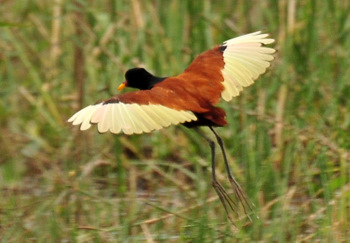 In the afternoon we hike from the station to the Normandy lagoon, through a forest island. Forest islands are clusters of trees isolated from others by flooded plains during the rainy season. The variety of trees in the island is amazing. Johnny quotes us the names of trees and palms and explains their uses. We spot a monkey, but it’s at the top of one of the tall trees and we barely see a hairball between the branches. The trail from the forest island to the lagoon passes through an area where the grass is chest-high. Johnny is going ahead and we blindly follow his footsteps, hoping not to step on a snake. Upon reaching the lake, we see an alligator but quite far. On the way back to the station we don’t see any wildlife, except for some birds.
In the afternoon we hike from the station to the Normandy lagoon, through a forest island. Forest islands are clusters of trees isolated from others by flooded plains during the rainy season. The variety of trees in the island is amazing. Johnny quotes us the names of trees and palms and explains their uses. We spot a monkey, but it’s at the top of one of the tall trees and we barely see a hairball between the branches. The trail from the forest island to the lagoon passes through an area where the grass is chest-high. Johnny is going ahead and we blindly follow his footsteps, hoping not to step on a snake. Upon reaching the lake, we see an alligator but quite far. On the way back to the station we don’t see any wildlife, except for some birds.
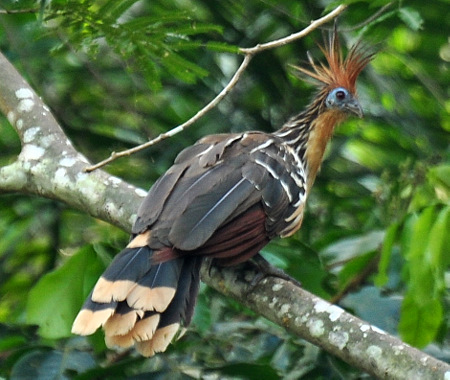 On the 24th we jump on the motorbikes, with backpacks and food for 2 days and go to the Marimono camp within the limits of the reserve. In the last stretch of road, the trail we follow is narrow and the bushes whip our legs until we go out to the open pampas. Here there is no trail and we just go cross country towards an island forest. Cattle graze on the pampa, leaving their deep footprints in the mud at the end of the rainy season, which dries out leaving a field full of holes that are impossible to avoid. Alan and Pedro just draw an imaginary straight line to the entrance of the forest island and only deviate from it to dodge the termite mounds. In this area we see 4 rheas but they quickly flee from us before we can approach them on foot.
On the 24th we jump on the motorbikes, with backpacks and food for 2 days and go to the Marimono camp within the limits of the reserve. In the last stretch of road, the trail we follow is narrow and the bushes whip our legs until we go out to the open pampas. Here there is no trail and we just go cross country towards an island forest. Cattle graze on the pampa, leaving their deep footprints in the mud at the end of the rainy season, which dries out leaving a field full of holes that are impossible to avoid. Alan and Pedro just draw an imaginary straight line to the entrance of the forest island and only deviate from it to dodge the termite mounds. In this area we see 4 rheas but they quickly flee from us before we can approach them on foot.
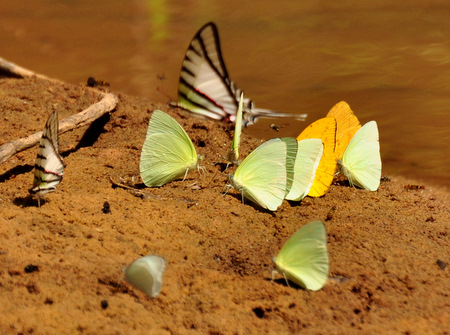 Riding in the forest island causes us a strange feeling. We follow a trail more or less marked, dodging fallen palm fronds and low vines. It seems that at any moment, a tapir or a capybara frightened by the noise of the engines, can cross the trail. We reach the river that marks the boundary of the reserve, park the bikes and cross the murky river walking on the canoe which serves as a bridge. We are in the Marimono camp. While Pedro opens the door of the only existing building, Alan picks up some mandarin-lemons, from one of the trees nearby. There is also a banana tree and several pineapple plants, but unfortunately they are not ripe yet. In the afternoon, when the heat begins to relax we go on a jungle expedition. Pedro goes ahead, opening trail with the machete, on an old trail that has been reabsorbed by the jungle. A few years ago it was used during the monitoring rounds, but the area has been declared a “core zone” and the management has decided to limit the presence of humans in it. However, indigenous communities are allowed to hunt there. On top of the machete noise, the terrain is covered with dry leaves and branches that crunch under our feet scaring away any animal that might be around. Besides the vegetation, we see no animals. Well, the ant caravans carrying leaves to their nest are impressive. The trails they make are the only areas free of leaves in the forest. Alan and Pedro show us how to get fresh water from the trunk of the cat's claw tree. They cut a 3-feet section of the twisted branches and we all drink from it. When empty, we can see that it has a hard structure but very porous, where it stores large amounts of water.
Riding in the forest island causes us a strange feeling. We follow a trail more or less marked, dodging fallen palm fronds and low vines. It seems that at any moment, a tapir or a capybara frightened by the noise of the engines, can cross the trail. We reach the river that marks the boundary of the reserve, park the bikes and cross the murky river walking on the canoe which serves as a bridge. We are in the Marimono camp. While Pedro opens the door of the only existing building, Alan picks up some mandarin-lemons, from one of the trees nearby. There is also a banana tree and several pineapple plants, but unfortunately they are not ripe yet. In the afternoon, when the heat begins to relax we go on a jungle expedition. Pedro goes ahead, opening trail with the machete, on an old trail that has been reabsorbed by the jungle. A few years ago it was used during the monitoring rounds, but the area has been declared a “core zone” and the management has decided to limit the presence of humans in it. However, indigenous communities are allowed to hunt there. On top of the machete noise, the terrain is covered with dry leaves and branches that crunch under our feet scaring away any animal that might be around. Besides the vegetation, we see no animals. Well, the ant caravans carrying leaves to their nest are impressive. The trails they make are the only areas free of leaves in the forest. Alan and Pedro show us how to get fresh water from the trunk of the cat's claw tree. They cut a 3-feet section of the twisted branches and we all drink from it. When empty, we can see that it has a hard structure but very porous, where it stores large amounts of water.
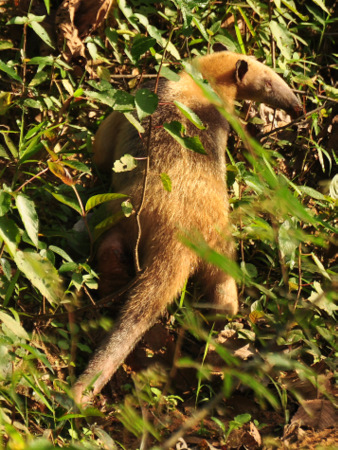 The next morning we go for a canoe ride on the river Curiraba. The canoe is just a big empty trunk. A few sticks crossed and stuck between its inner walls are our seats. Alan and Pedro push it with the help of long poles. The concert of all types of birds is spectacular. From the boat we can see some of them. On top of the many herons, we spot a couple of flocks of hoatzins, with their curious crests of feathers. Halfway downstream, Pedro spots a pigmy anteater near the shore. When we come close, it goes away climbing up the embankment that marks the edge of the river in the rainy season. This will be the most interesting animal we see during the trip. Going back up we see a monkey, but high in the treetops. The truth is that to be a biosphere reserve, it’s a bit poor in wildlife. We suspect that the chimanos, who use the river to hunt, have killed most of the animals or they have moved to more inaccessible and quieter areas. On the banks of the river near the camp, lots of butterflies of different species land on the mud to lick the salts deposited there by the water. We return to the station through another route, but equally tortuous. We say goodbye to Johnny, Alan and Pedro and we go to the main road to wait for a passing taxi to take us to San Borja. At night we have dinner with Alan who has had to return ahead of time to the village.
The next morning we go for a canoe ride on the river Curiraba. The canoe is just a big empty trunk. A few sticks crossed and stuck between its inner walls are our seats. Alan and Pedro push it with the help of long poles. The concert of all types of birds is spectacular. From the boat we can see some of them. On top of the many herons, we spot a couple of flocks of hoatzins, with their curious crests of feathers. Halfway downstream, Pedro spots a pigmy anteater near the shore. When we come close, it goes away climbing up the embankment that marks the edge of the river in the rainy season. This will be the most interesting animal we see during the trip. Going back up we see a monkey, but high in the treetops. The truth is that to be a biosphere reserve, it’s a bit poor in wildlife. We suspect that the chimanos, who use the river to hunt, have killed most of the animals or they have moved to more inaccessible and quieter areas. On the banks of the river near the camp, lots of butterflies of different species land on the mud to lick the salts deposited there by the water. We return to the station through another route, but equally tortuous. We say goodbye to Johnny, Alan and Pedro and we go to the main road to wait for a passing taxi to take us to San Borja. At night we have dinner with Alan who has had to return ahead of time to the village.
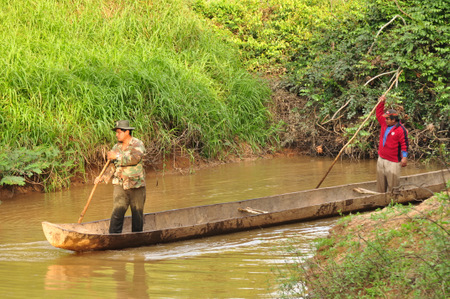 We had high expectations to see abundant wildlife in the reserve, but we have seen more animals on the road than in the reserve itself. We get the impression that the overhunting and mismanagement by the park managers, who don’t provide funds to maintain and open new trails, are the main reasons. However, in addition to the wildlife we've seen in the 5-day bike route, in the reserve we have enjoyed the conversations with the rangers and their explanations of the flora and fauna, in addition to the menus of our chef.
We had high expectations to see abundant wildlife in the reserve, but we have seen more animals on the road than in the reserve itself. We get the impression that the overhunting and mismanagement by the park managers, who don’t provide funds to maintain and open new trails, are the main reasons. However, in addition to the wildlife we've seen in the 5-day bike route, in the reserve we have enjoyed the conversations with the rangers and their explanations of the flora and fauna, in addition to the menus of our chef.
Go to top
© 2014 Explore Pangea. All Rights Reserved. Website
Terms
of Use.























